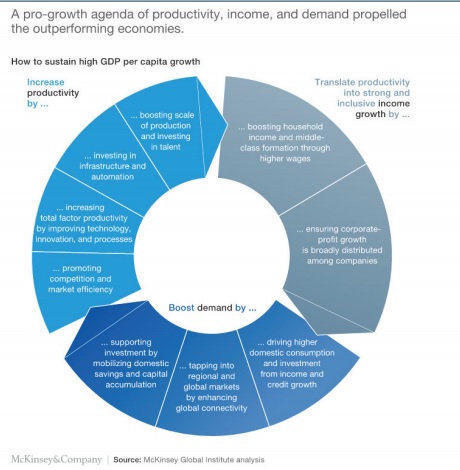
Ethiopia, the report points out, is seeing vibrant manufacturing growth and increased manufacturing employment by almost 10 percent and value added by 7 percent a year between 2000 and 2010.
According to the report, Ethiopia has potential to increase employment in manufacturing by 3.6 percentage points and value added by 2.3 percentage points by 2030 based on McKinsey estimates. Rwanda and Kenya are the other economies in the region with similar potential. Elsewhere, they include Bangladesh, India, Mozambique, Nepal, and Vietnam.
The report touts manufacturing because it does not just create jobs and growth in manufacturing-related sectors but has a broader impact on productivity and employment in the economy.
In Ethiopia, for example, if these induced effects are included, manufacturing has had a significant multiplier effect of more than five times, compared with three times for services. The multiplier effect for output is about 2.3 times, compared with 1.9 times for services. As manufacturing jobs have higher wages, the multiplier impact on output will also be higher than for services.
A 2015 McKinsey survey of chief purchasing officers from garment majors in Europe found that Ethiopia was attracting growing interest as a future top sourcing destination. It is listed together with India, Myanmar, Turkey, and Vietnam.
Exporting problem
Generally, the McKinsey report notes that Sub-Saharan Africa needs to focus more on sophisticated exports and better governance
It points out that this is the second poorest of regions, with GDP per capita of about $1,750, or only about one-seventh that of East and Southeast Asia and of Central and Eastern Europe.
Of the 15 countries analyzed in the region, only Ethiopia has grown at more than five percent a year over the past 20 years. Ghana, Mozambique, and Rwanda, which have undergone recent growth spurts, have outpaced the long-term outperformers in the past 10 years.
Tanzania and Uganda have been more consistent growers among middling economies, while Angola and Nigeria have had a more volatile past. Six underperforming economies—Cameroon, Côte d’Ivoire, Kenya, South Africa, Zambia, and Zimbabwe—have declined relative to the United States in the past decades,although Côte d’Ivoire’s economic performance has improved.
Exports from the region as a percentage of GDP were below 30 percent on average, which is half the rate seen in outperforming economies. Connectedness to other regions is poor, and the diversity and complexity of the export portfolio is low. For example, more than 90 percent of exports from Nigeria and Angola are oil-related products. Similarly, more than 80 percent of exports from Ghana, Senegal, Tanzania, and Zimbabwe are commodities or natural resources. Without a strong and diverse export-oriented sector, economic growth can be limited by domestic income and be affected by the volatility of commodity prices.
Manufacturing offers a potential avenue to enhance export complexity and connectedness. Most sub-Saharan economies still have large opportunities to generate employment and increase productivity in the manufacturing sector, as their current manufacturing share of employment is low. Previous MGI research estimated that Africa could nearly double its manufacturing output from $500 billion in 2016 to $930 billion in 2025. Three-quarters of this potential growth could come just from meeting domestic demand—the continent currently imports more than one-third of the food, beverages, and consumer goods it consumes—while the other one-quarter could come from exports to other regions.
Poor infrastructure, cumbersome customs processes, and lax compliance with social and environmental norms by countries in East Africa limit their ability to host apparel makers and other labour-intensive manufacturers. Lack of required talent and high cost of labour also pose a challenge. Ethiopia is a notable exception to these limitations is Ethiopia, as it has used labour-intensive manufacturing to achieve stronger growth. Countries focused on oil exports face the challenge of currency appreciation when seeking to offer competitive prices in other export sectors.
Additionally, there are opportunities to improve government effectiveness across most countries in the region. While a few economies—Côte d’Ivoire, Kenya, and Zimbabwe— showed improvement in the World Bank Government Effectiveness Index from 2010 to 2016, other countries in the region have not. This region has one of the lowest average scores in the Ease of Doing Business Index, but is improving at the second-fastest rate, indicating that these countries are focused on improving the environment for their private sectors. The market capitalisation of listed domestic companies grew by 3 percent between1996 and 2016 while corporate income grew by 7 percent between 1996 and 2014.
Sub-Saharan Africa shows the lowest score in the McKinsey Digital Maturity Index. Countries in this region need to invest in digital infrastructure to ensure access, improve government’s adoption of the latest technologies, and incentivize the development and adoption of ICT by local companies. However, this region has also experienced fast development especially in its mobile technology. Mobile phone penetration in the region has grown by more than 12 percent annually on average since 2010, which is the second fastest rate after East Asia and Pacific, according to the World Bank’s Financial Inclusion Index. Up to 7 percent of the adult population of these countries uses mobile payment technology, second only to East Asia and Southeast Asia, where 10 percent does.
The biggest challenges for sub-Saharan African countries involve improving export industries and global connectivity, which may include investing in infrastructure and labour force training as well as improving government efficacy and strengthening financial services.
Continuing improvements in technology, especially in mobile and digital innovation and connectivity, will enable sub-Saharan Africa to grow at a faster rate.
But the report says, there are reasons to be optimistic about the future of sub-Saharan Africa. Per capita GDP growth was slightly above 3 percent per year between 2010 and 2015, while labour productivity grew by 2.5 percent annually in the same period, a higher rate than the Middle East and North Africa, Latin America, or Central and Eastern Europe. Similarly, investment rates reached almost 26 percent per year from 2010 to 2015, while household incomes grew 3.7 percent.
McKinsey estimates that four industry groups; consumer-facing sectors, agriculture, resources, and infrastructure—together could generate as much as $2.6 trillion in revenue annually between 2010 and 2020, or $1 trillion a year more than before. The large share of the population living in urban areas (above 40 percent) will also open new business opportunities.
 The Independent Uganda: You get the Truth we Pay the Price
The Independent Uganda: You get the Truth we Pay the Price



I thoroughly delighted in that people. I truthfully carry
out not comprehend just how might you produce this type of
top quality short articles each and every single time!
It type of reminded me of https://bringbackalan.com, however this seems to be to have even more degree.
Thanks for constantly sharing your own know-how!